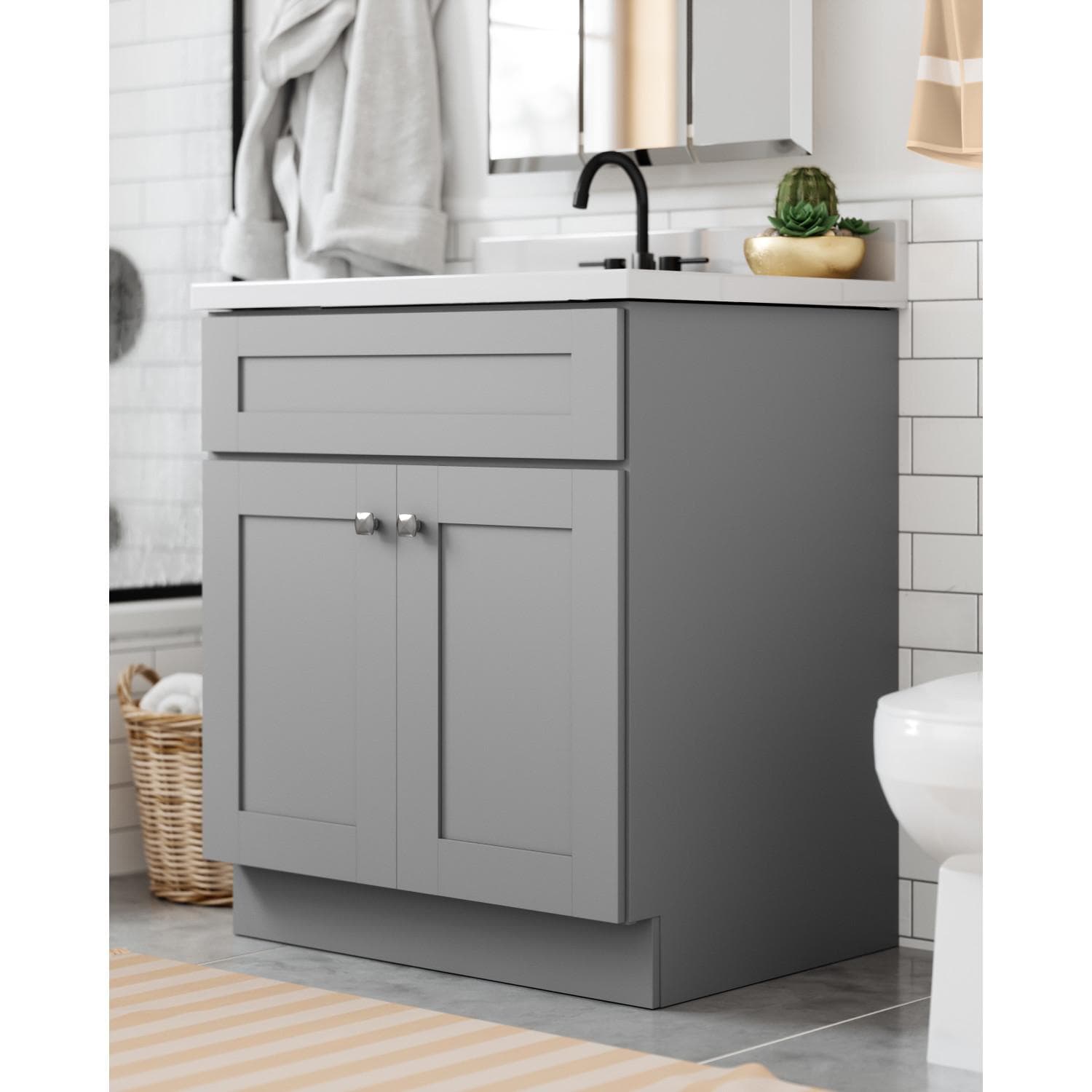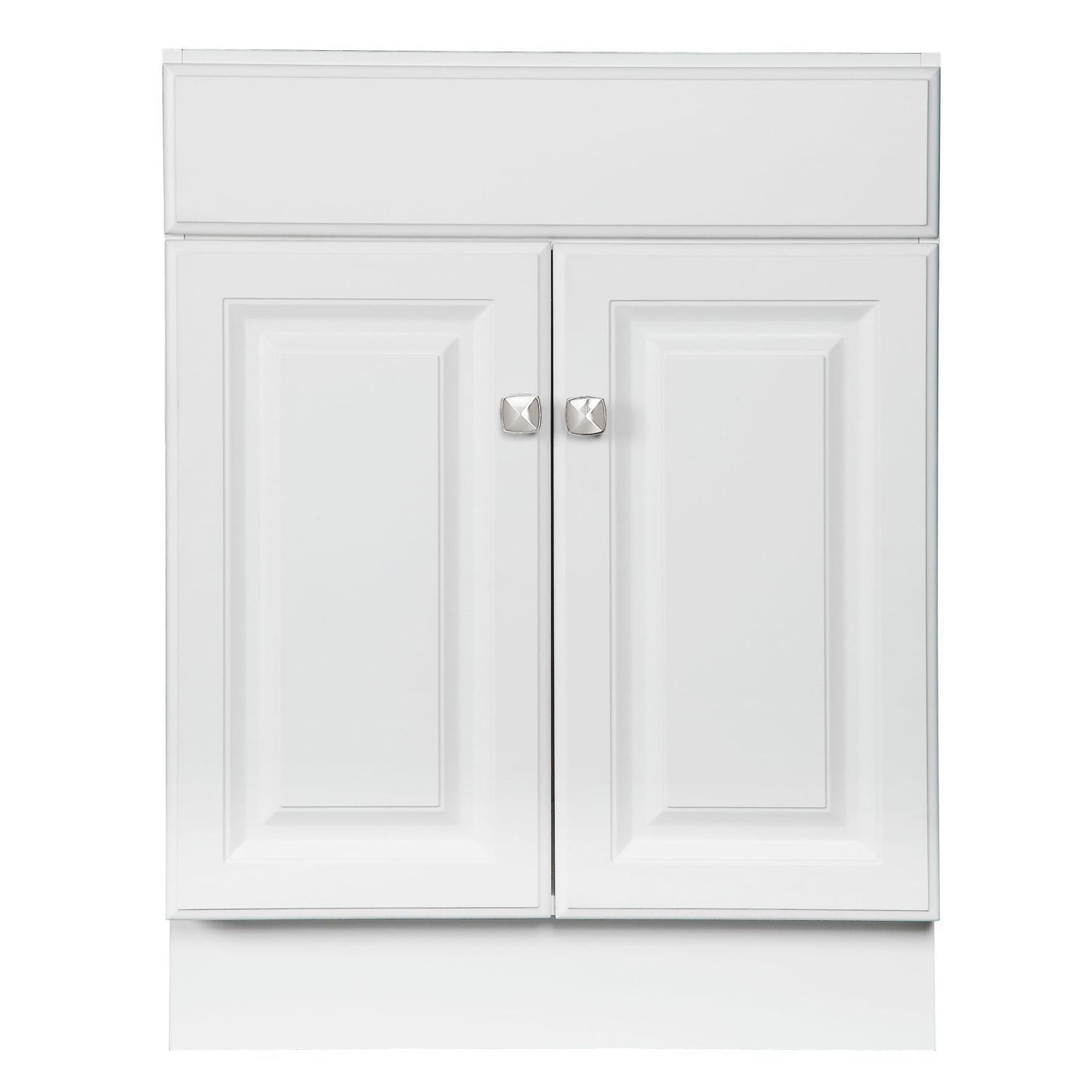Installation and Setup: Bathroom Vanity Without Faucet Holes

Installing a bathroom vanity without faucet holes is a straightforward process that requires careful planning and execution. This section will guide you through the steps involved, outlining the necessary tools and materials, and providing tips for a successful installation.
Tools and Materials
A well-equipped toolkit is essential for a smooth installation. The following tools and materials are recommended:
- Level: Ensures the vanity is installed horizontally and prevents water from pooling.
- Measuring Tape: Accurately measures the space for the vanity and determines the position of the drain pipe.
- Pencil: Marks the wall for drilling holes and Artikels the vanity’s position.
- Drill: Creates holes for mounting the vanity to the wall and for attaching the drain pipe.
- Screwdriver: Secures the vanity to the wall and assembles any components.
- Wrench: Tightens the drain pipe connections.
- Caulk Gun: Applies sealant around the vanity to prevent water damage.
- Silicone Sealant: Seals the gaps between the vanity and the wall, preventing water leakage.
- Plumber’s Putty: Seals the drain pipe connection to prevent leaks.
- Vanity Screws: Securely attach the vanity to the wall.
- Drain Pipe: Connects the vanity to the drain system.
- Faucet and Installation Kit (Optional): If you choose to install a faucet later, ensure you have the appropriate kit.
Installation Steps
The installation process involves several steps, each requiring careful attention to detail.
- Prepare the Area: Clear the area around the vanity, removing any obstructions. Ensure the floor is clean and dry.
- Measure and Mark: Measure the space where the vanity will be installed and mark the wall with a pencil. The vanity should be level and centered in the space.
- Install the Drain Pipe: Connect the drain pipe to the vanity’s drain hole and ensure a secure fit. Use plumber’s putty to seal the connection and prevent leaks.
- Attach the Vanity to the Wall: Drill pilot holes into the wall at the marked locations and secure the vanity with screws. Use a level to ensure the vanity is installed horizontally.
- Install the Faucet (Optional): If you are installing a faucet, follow the manufacturer’s instructions carefully. Use the appropriate tools and sealant to ensure a watertight connection.
- Seal the Gaps: Apply silicone sealant around the vanity to prevent water damage. Ensure the sealant is smooth and even.
- Test for Leaks: Turn on the water supply and check for any leaks. If there are any leaks, tighten the connections or reapply sealant as needed.
Tips and Techniques
Here are some additional tips and techniques to ensure a successful installation:
“Always double-check your measurements and ensure the vanity is level before drilling holes.”
- Use a Level: A level is essential to ensure the vanity is installed horizontally. This prevents water from pooling and ensures a smooth and aesthetically pleasing installation.
- Pre-drill Pilot Holes: Pre-drilling pilot holes into the wall before attaching the vanity screws prevents the wood from splitting and makes the installation easier.
- Use a Quality Drain Pipe: Choose a drain pipe made of durable material that is resistant to corrosion and leaks.
- Secure the Drain Pipe Connection: Ensure the drain pipe is securely connected to the vanity’s drain hole and use plumber’s putty to prevent leaks.
- Apply Sealant Carefully: Apply sealant around the vanity to prevent water damage. Ensure the sealant is smooth and even, and allow it to dry completely before using the vanity.
- Test for Leaks: Always test for leaks after installation. Turn on the water supply and check for any leaks. If there are any leaks, tighten the connections or reapply sealant as needed.
Faucet Options

Installing a vanity without faucet holes presents a unique opportunity to choose a faucet that perfectly complements your bathroom design. This approach allows for greater flexibility in style and functionality, offering a wide range of options to suit diverse preferences and budgets.
Faucet Types
Choosing the right faucet type for a vanity without faucet holes depends on the desired functionality, style, and budget. The most common types include:
- Wall-Mounted Faucets: These faucets are installed directly on the wall, eliminating the need for holes in the vanity. They offer a sleek and modern look, freeing up counter space and creating a minimalist aesthetic. Wall-mounted faucets are available in various styles, from contemporary to traditional, and can be single-hole, widespread, or centerset.
- Deck-Mounted Faucets: These faucets are mounted on the countertop, requiring a dedicated platform or a custom-built base to accommodate them. They offer a more traditional look and are available in a wide range of styles, including single-handle, two-handle, and widespread options. Deck-mounted faucets provide a robust and reliable solution, particularly for larger vanities.
- Freestanding Faucets: These faucets stand independently on the countertop, offering a unique and modern look. They typically feature a tall spout and a wide base, providing a statement piece in the bathroom. Freestanding faucets are ideal for creating a luxurious and sophisticated ambiance.
Faucet Finishes, Bathroom vanity without faucet holes
Faucet finishes play a significant role in the overall aesthetic of the bathroom. Popular options include:
- Chrome: A classic and timeless finish that reflects light and adds a touch of elegance to the bathroom. Chrome is durable and easy to clean, making it a popular choice for busy households.
- Brushed Nickel: A modern and sophisticated finish that provides a warm and inviting ambiance. Brushed nickel offers a subtle texture and a soft sheen, complementing a variety of bathroom styles.
- Matte Black: A bold and contemporary finish that adds a touch of drama to the bathroom. Matte black creates a striking contrast against lighter backgrounds and complements industrial and modern styles.
- Oil Rubbed Bronze: A warm and rustic finish that adds a touch of vintage charm to the bathroom. Oil rubbed bronze creates a rich and layered effect, complementing traditional and transitional styles.
Faucet Features
Faucet features can enhance functionality and user experience. Common features include:
- Pull-Down Sprayer: A convenient feature that allows for easy switching between a stream and a spray, ideal for rinsing dishes or filling pots.
- Touchless Sensor: A modern and hygienic feature that activates the water flow with a simple touch or wave of the hand. Touchless faucets are particularly useful in busy bathrooms.
- Temperature Control: Features like thermostatic valves or digital controls allow for precise temperature settings, ensuring a comfortable and safe showering experience.
Faucet Price
Faucet prices vary depending on the type, finish, and features. Generally, wall-mounted faucets are more expensive than deck-mounted faucets, while freestanding faucets are the most expensive option. High-end finishes like brushed nickel or matte black often come at a premium compared to standard chrome finishes.
Popular Brands and Products
Choosing the right bathroom vanity without faucet holes can be a bit overwhelming, with so many options available. Understanding the features, quality, and price points of different brands can help you make an informed decision.
Popular Brands and Their Offerings
A wide range of brands offer bathroom vanities without faucet holes. Some popular choices include:
- Kohler: Known for its high-quality and stylish designs, Kohler offers a variety of vanities without faucet holes, including the “Wellspring” and “Purist” collections. Their vanities are durable, with a wide range of finishes and styles to suit different bathroom aesthetics.
- American Standard: American Standard offers a wide range of bathroom vanities, including the “Studio” and “Town Square” collections. Their vanities without faucet holes are known for their affordability and practicality, with a focus on functionality and ease of installation.
- Moen: Moen is known for its innovative and stylish bathroom products, including vanities. Their “Align” and “Arbor” collections feature vanities without faucet holes, combining modern design with practical features.
- Delta Faucet: While primarily known for faucets, Delta Faucet also offers a range of bathroom vanities. Their “Trinsic” and “Cassidy” collections feature vanities without faucet holes, with a focus on sleek and contemporary designs.
- TOTO: TOTO is a leading manufacturer of high-end bathroom fixtures, including vanities. Their “Neorest” and “Soiree” collections offer luxurious vanities without faucet holes, known for their innovative technology and elegant aesthetics.
Comparing Products
When comparing bathroom vanities without faucet holes, it’s essential to consider factors like:
- Material: Vanities are often made from wood, such as oak, maple, or cherry, or from engineered materials like MDF or plywood. Wood vanities are generally more expensive but offer a natural and elegant look, while engineered materials provide durability and affordability.
- Finish: Vanities come in various finishes, including painted, stained, or lacquered. The finish should complement your bathroom’s overall style and withstand moisture and humidity.
- Storage: Consider the amount of storage space you need, including drawers, shelves, and cabinets. Some vanities offer additional features like built-in organizers or pull-out drawers for maximizing storage.
- Style: Choose a style that complements your bathroom decor, whether it’s traditional, modern, contemporary, or transitional.
- Size: Measure your bathroom space carefully to ensure the vanity fits comfortably and allows for adequate movement.
Top Five Bathroom Vanities Without Faucet Holes
Here is a table showcasing five popular bathroom vanities without faucet holes from different brands:
| Brand | Model | Material | Finish | Price Range |
|---|---|---|---|---|
| Kohler | Wellspring 36″ Vanity | Oak | White | $1,500 – $2,000 |
| American Standard | Studio 30″ Vanity | MDF | Espresso | $500 – $700 |
| Moen | Align 36″ Vanity | Maple | Gray | $1,000 – $1,500 |
| Delta Faucet | Trinsic 30″ Vanity | Plywood | White | $700 – $900 |
| TOTO | Neorest 48″ Vanity | Cherry | Walnut | $3,000 – $4,000 |
Trends and Innovations

Bathroom vanities without faucet holes represent a growing trend in bathroom design, driven by a desire for minimalist aesthetics, flexibility, and personalized style. This design approach allows homeowners to select and install faucets that perfectly complement their vanity and overall bathroom decor.
Modern and Contemporary Designs
The absence of pre-drilled holes offers designers and homeowners a blank canvas for creativity. This has led to the emergence of innovative and stylish bathroom vanities that embrace modern and contemporary design principles.
- Sleek and Minimalist Aesthetics: Vanities with clean lines, geometric shapes, and a lack of visible hardware embody a minimalist aesthetic that is both timeless and modern. The absence of faucet holes further enhances this clean look.
- Integrated Sinks: Integrated sinks seamlessly blend with the vanity countertop, creating a unified and streamlined design. This approach eliminates the need for separate sink basins and faucet holes, contributing to a minimalist aesthetic.
- Statement Pieces: Vanities without faucet holes provide an opportunity to make a bold statement with unique designs and materials. These vanities can become focal points in the bathroom, showcasing the homeowner’s individual style and taste.
Future Developments
The trend towards vanities without faucet holes is expected to continue, with further innovations emerging in the years to come.
- Smart Technology Integration: Future vanities may incorporate smart technology features such as touchless faucets, voice-activated controls, and integrated lighting systems. These features will enhance convenience and functionality while maintaining a sleek aesthetic.
- Sustainable Materials: The use of sustainable and eco-friendly materials, such as recycled wood and natural stone, will become increasingly prevalent in bathroom vanity design. This aligns with the growing awareness of environmental responsibility.
- Modular and Customizable Designs: Vanities will likely become more modular and customizable, allowing homeowners to choose from a variety of sizes, shapes, finishes, and storage options to create a vanity that perfectly fits their needs and preferences.
